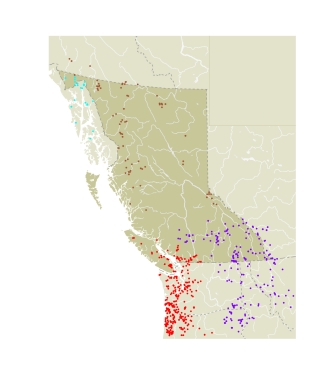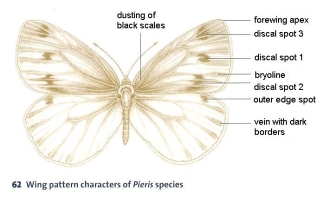Pieris was one of the Muses (Pierides) who lived on Mt. Pierus, close to Mt. Olympus. Pieris was one of the five families into which Schrank divided the butterflies. Originally Schrank applied the name to all the swallowtails and whites, with the first species name being apollo (Apollo was the patron of the Muses). Latreille later separated the swallowtails and whites, applying the name Pieris to what we now call the family Pieridae (Emmet 1991). The common name "whites" is shared with Pontia and refers to the predominantly white colour of the wings.
Whites in the genus Pieris are all medium-sized white butterflies with black markings and, especially when newly emerged, with pale yellow ventral hindwings. Some females of all the species are entirely yellow. The genus Pontia includes other species of whites.
The eggs of whites are conical, with vertical ribs down the sides and numerous small horizontal ridges between the vertical ribs. The eggs are pale yellow or yellow green. Eggs are laid singly on the leaves or flowers of plants in the mustard family (Brassicaceae), both cultivated species and native mustards. Mature larvae are green and smooth-skinned with a thin coat of fine hairs. Whites hibernate as pupae, which are roughly cylindrical and smooth except for dorsal and dorsolateral ridges; the pupae are held against a stem or other vertical surface with a girdle.
In the genus Pieris, the cross-vein at the end of the forewing discal cell curves inward towards the wing base. Unlike in the genus Pontia, this vein is not surrounded by a black spot. There are dark borders to the veins on the ventral hindwing and ventral forewing apex, except in the Cabbage White and summer broods of some other species. Geiger and Scholl (1985) and Robbins and Hensen (1986) showed that Artogeia Verity, 1947, into which some authors have placed the BC species of Pieris, is a synonym of the genus Pieris.
Until recently only two species of the genus Pieris were thought to occur in BC, the introduced Cabbage White and the Holarctic Pieris napi. Instead, there are four species of Pieris in BC, and it is now clear that Pieris napi does not occur in North America (Geiger and Shapiro 1992).
Eitschberger (1983) proposed four BC species: P. rapae, P. marginalis (four subspecies), P. oleracea, and P. angelika, which are distinguished by small differences in wing pattern characteristics. The fact that Eitschberger's book was in German, its high cost, and unreasonably critical reviews of this book by Kudrna and Geiger (1985), Ferris (1989), and Shapiro (1985b) combined to make Eitschberger (1983) ignored by most North American authors. Eitschberger's revision of Pieris is substantially supported by the electrophoretic data of Geiger and Shapiro (1992), however, which has led to a grudging acceptance of parts of his work.
During the preparation of this book, we examined several series of northern Pieris collected by Norbert Kondla and CSG, and various museum specimens. CSG conducted further sampling and rearing of northern BC Pieris. Two Pieris are sympatric in various northern locaIities, from Valemont to the southern Yukon: P. oleracea and P. marginalis tremblayi. Near the Yukon border, they a rejoined by a third species, P. angelika. Eitschberger's P. marginalis guppyi is electrophoretically quite distinct from P. marginalis marginalis (Geiger and Shapiro 1992), and the wing pattern of tremblayi indicates that it is closely related to guppyi. This suggests that guppyi and tremblayi may be a separate species from
P. marginalis. We do not raise Pieris guppyi to species status, with tremblayi as a subspecies of guppyi, because the electrophoretic data are, by themselves, insufficient to separate the taxa into two species.
|

